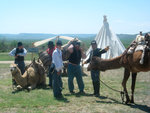

If someone was to say that camels used to roam the wild west, would that be a little hard to believe? According to Yacolt author Sherry Alexander, that little known fact is not folklore.
An avid history buff, Alexander was perusing old drawings one day and came across two renderings by Edward Vischer - Washoe Mining Region and the Mammoth Grove. Vischer was a German-born painter and photographer who went on a mining expedition in Nevada and California. While there he witnessed camels with packs on them, just as horses would be weighed down, and miners were riding them. He was shocked to discover camels in North America and began sketching what he saw. In her recently-released e-book, The Great Camel Experiment of the Old West, Alexander outlines a brief period that could’ve drastically altered the landscape of American history. In 1855, after Jefferson Davis spear-headed a four year battle with Washington, D.C., Congress appropriated $30,000 to purchase camels from the Middle East and bring them to America to see how they’d fair up against more traditional beasts of burden such as donkeys, horses and even oxen.
During the Gold Rush, people began crossing America by the thousands in wagon trains and, due to the fact that no one knew where to find reliable water sources and the vastness of the prairies they were crossing, animals weren’t surviving. Many were lost each trip from dehydration and famine. Additionally, forts were few and far between, so supplying them was a costly prospect. The government was open to options and Davis had a viable, albeit unconventional, one.
According to Alexander‘s research, camels ate cactus, mesquite and virtually anything along the dry and dusty prairie land. Better still, they could go three full days without water, whereas horses and mules needed to be watered daily and sometimes two to three times each day depending on conditions. The experiment was declared a success.
Unfortunately, two years later Davis left his position as secretary of war and the camels lost their most passionate proponent. There were also growing grumblings by shippers who were upset at a camel’s ability to carry 1,000 pounds each. As Alexander explained it, a string of 10 camels could carry 10,000 pounds to stock forts. They could travel through the mud, the rain and the heat of the desert regions. Railroads were poised to lose considerable revenue. To make matters worse, Jefferson Davis became the president of the Confederacy in the Civil War. The Camel Experiment fell out of favor.
For a time, confederate soldiers used camels to carry the mail and transport salt back and forth through Mexico, but eventually the camels were auctioned off by the government. Alexander said that a lot of them were sold to circuses and some were used to haul salt and silver for miners up until the 1870s.
Included in Alexander’s book are also 20 one-color photographs taken during live re-enactments by the Texas Camel Corps. The group dedicates itself to preserving this little-known piece of American history through Living History Days, school events and overnight camel treks.
“Doug Baum from Texas Camel Corps supplied all the photos for the book,’’ Alexander said. “I didn’t want to use historical photos because they’d be photos used in other books so we used re-enactment photos to bring it all to life.”
The Great Camel Experiment of the Old West is not Alexander’s first writing endeavor. She had a parenting column in The Oregonian Newspaper in the 1980s, had a book released in 1987 and then landed a full-time job as a police dispatcher for the City of Portland for 20 years. Through her research on the camel experiment, she uncovered the story of a large male camel who caused a lot of havoc in the 1880s and is working on a book entitled Jake’s Search for the Red Goat.
The Great Camel Experiment of the Old West can be purchased through all major e-book retailers such as Amazon, Apple Store, Barnes & Noble and Google books. Look for it soon on OverDrive, the library lending site.